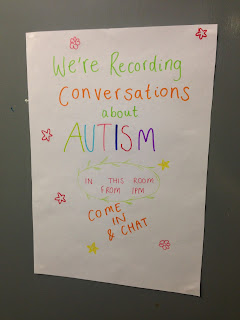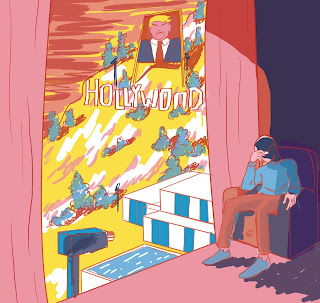My mum gave me a book to read called The Reason I Jump by Naoki Higashida, a boy with autism who was 13 at the time of writing the book.
He would be considered quite severely autistic, as he is unable to speak and used a computer, and alphabet grid and a transcriber to write the book.
This book has been very useful in my research, as it gives me an inside perspective from someone who actually has autism, about how people with autism experience the world, and what they want people without it to understand about them. This has been invaluable considering the aims of the brief are to portray autism in a more positive light, and our specific aim as a group is to normalise autism and show people with it as perfectly functional human beings.
This book is also helping me to create my audio file for my animation, as I've been feeling overwhelmed at the thought of condensing 13 minute's of Luke's interview to about 30 seconds. The book is constructed as a Q&A format; so Higashida answers common questions he faces about his autism and tries to communicate why he does things differently to what people might expect.
This has caused me to consider what I personally want people to understand about autism, and what I think Luke wants people to understand, based on his interview.
Again, I think just discussing his hobbies and daily life and normalising autism is the way forward. I'm feeling more able to pick out important bits of the conversation to form a 30 second narrative about a normal guy, who happens to have autism, who wants to be understood a bit better.
I hope that our target audience - people who don't really know what autism is or have an experience of it - manages to identify our aims through these animations.
Tuesday, 28 February 2017
Sunday, 26 February 2017
Choosing a song
Luke mentioned the Zelda games in his interview so I'm trying to find a song that kinda matches the theme tune - whimsical and adventurous in tone.
Friday, 24 February 2017
Meeting with interview candidates NAS
We held an open call for people with experience of autism to come and talk to us so we could record their personal experience and get a soundtrack and a focus for our animations.
6 people showed up - 3 with autism and 3 with experience of autism (autistic siblings). The interviews ranged from about 7 minutes to 20 minutes.
Luckily, as there are 3 people with autism and 3 of us in the group, we decided to use them as it was more personal and we want to show that you shouldn't treat people with autism differently. We all picked one person who we felt we could animate, based on visual cues they gave in the interviews. I chose Luke!
6 people showed up - 3 with autism and 3 with experience of autism (autistic siblings). The interviews ranged from about 7 minutes to 20 minutes.
Luckily, as there are 3 people with autism and 3 of us in the group, we decided to use them as it was more personal and we want to show that you shouldn't treat people with autism differently. We all picked one person who we felt we could animate, based on visual cues they gave in the interviews. I chose Luke!
Thursday, 23 February 2017
Moby New Statesman Brief
I did this brief very quickly in the midst of all the other work I'm doing. Quick roughs/ideas:
I wasn't too happy with the final thing. It was very rushed as I did it in the early hours before the deadline, and I could have adjusted it after but I didn't really want to. I do like the colours though, and want to try this colour scheme out again at some point.
I wasn't too happy with the final thing. It was very rushed as I did it in the early hours before the deadline, and I could have adjusted it after but I didn't really want to. I do like the colours though, and want to try this colour scheme out again at some point.
Life, Animated - autism documentary research for NAS brief
A documentary about a boy with autism who grew up using animated Disney movies to learn to communicate.
Relevant to the brief we're doing and our response to the brief.
The trailer on YouTube also has a lot of positive comments/reviews from people with autism themselves, which shows that this documentary is well-made and representative of the experience of autism.
Key points:
Owen found the exaggerated expressions and emotions in Disney movies easier to understand than in real life. This is because autistic people often have trouble reading people's faces. It might be useful to use this info in our own animations when we create them!
Tuesday, 21 February 2017
Bookbinding Workshop
3 hole pamphlet stitch
Important:
Leave a 5mm overhang of the pages when measuring the cover - the book must be able to lie flat!
Important for you to cut the corners diagonally, but leaving 3mm spaceso as to cover the corners of the card!
I was very happy with the outcome of this workshop, and I've learned a very valuable skill. I think I could apply bookbinding to my practice, as I am making a comic. I was thinking that the comic should be presented in traditional comic format (i.e. stapled paper) when I finish with it, but I could produce a special hardback edition of it, as I would like to make use of this new skill!
Important:
Leave a 5mm overhang of the pages when measuring the cover - the book must be able to lie flat!
Important for you to cut the corners diagonally, but leaving 3mm spaceso as to cover the corners of the card!
I was very happy with the outcome of this workshop, and I've learned a very valuable skill. I think I could apply bookbinding to my practice, as I am making a comic. I was thinking that the comic should be presented in traditional comic format (i.e. stapled paper) when I finish with it, but I could produce a special hardback edition of it, as I would like to make use of this new skill!
Monday, 20 February 2017
Software for Packaging Workshop
- A net is a 3D object flattened, e.g.:
- Lots of nets available online! Available as vector downloads to open in Illustrator.
- Nets can be lasercut, but make these yourself - don't rely on nets found online.
Making a Jack-in-the-box net:
- Make Layer 1 into a guides layer.
- Use the rectangle tool to draw a rectangle over the whole artboard.
- Object - path - split into grid
- Select preview, choose the number of columns
- Select add guides
- Double click the layer and make into a template. This will lock and dim the layer, and it will not print this layer.
- New layer called Net
- Rectangle tool - hold alt and this will help center it.
- Hold alt and select the square - this will copy the square and you can move it to start making the net.
- Using transform guarantees that the square moves to the exact right place.
- Make a cross from squares in the middle of the page.
- Make the tabs by making another rectangle the same height as the squares, but a smaller width.
- Use the direct selection tool to select the two outer corners of the tab.
- Use the circles inside to curve the edges.
- Select the two tabs you've made
- Find the rotate tool, hold it down to get the reflect tool.
- Alt + click on the axis where you want to reflect the shapes, i.e. on the middle guide (the blue point)
- Copy one of the tabs, rotate it and place it on the top box.
- Now we must make a clear outline! Otherwise the laser cutter would cut it out into a jigsaw.
- Select everything, then copy it.
- Create a new layer called Fold Guides 1
- Use edit - paste in place
- Lock and hide this new layer.
- Select original net layer
- Go to window - pathfider
- Select all the shapes
- Use the unite tool and your shapes should turn into one outline
- Lock the net layer
- Close pathfinder
- Select the folds layer
- Select all shapes
- You could reduce the opacity to differentiate between what needs to be cut and folded.
- OR a dotted line for folds
- Select all again
- Select stroke, and there will be an option for a dashed line
Now, to create a double sided image:
- Unlock all layers, including guides
- You can swap to view - outline mode, to check that all your lines line up
- Select artboard tool
- Rename artboard to 'inside of box'
- Hold down alt key
- Click and drag your artboard, and it will make a copy
- Rename it 'outside of box'
Alternative fold guides method
- Make a new layer called Fold Guides 2
- Lock all other layers
- Make some crop lines using the pen tool, holding down shift to get straight lines. they should snap to the guide lines.
- You'll need to score or fold the lines first before you cut with this method!
Printing!
- PDF retains vectors! More accessible than an AI file if you want to send it into the public domain.
- If you have a net that isn't symmetrical you'll have to reflect the shape horizontally, when printing.
- Print two-sided on long-edge binging
- Click use artboards when exporting
Voila! A box!
Thursday, 16 February 2017
Subscribe to:
Comments (Atom)

































